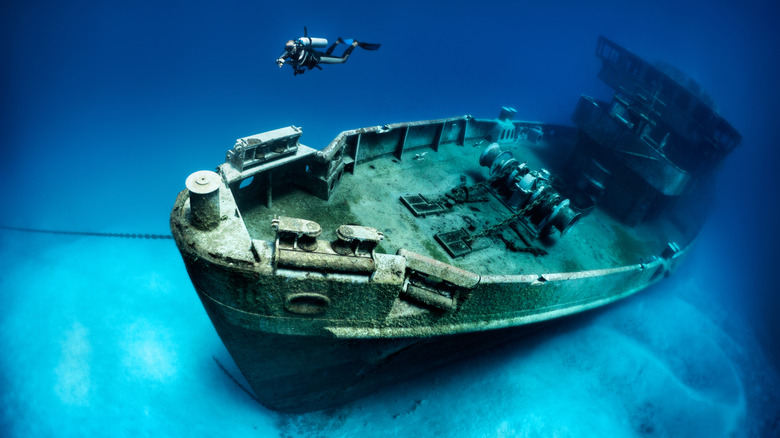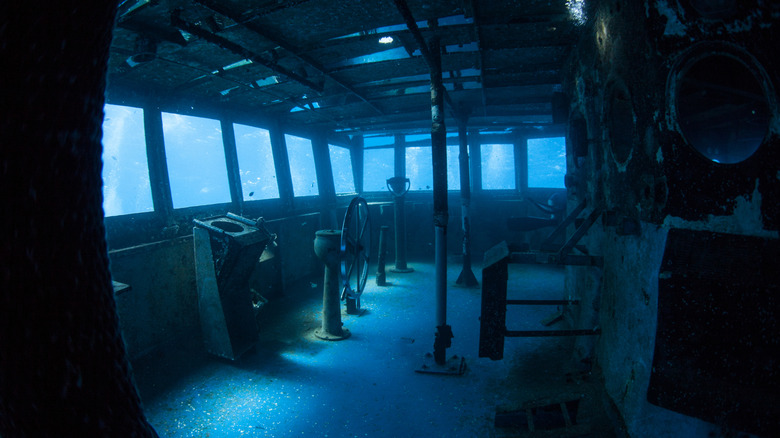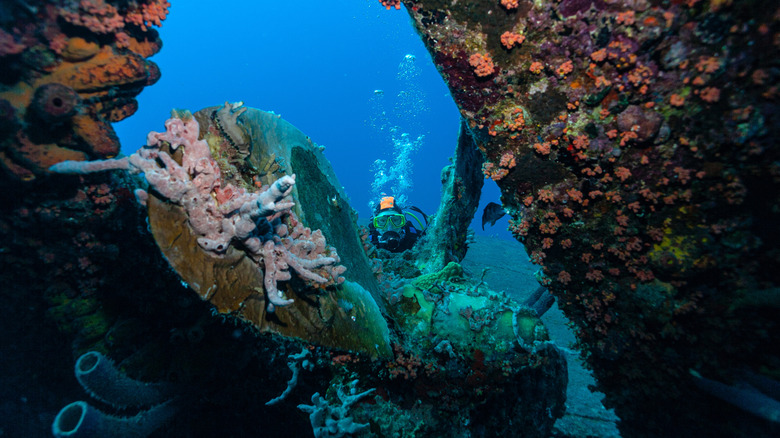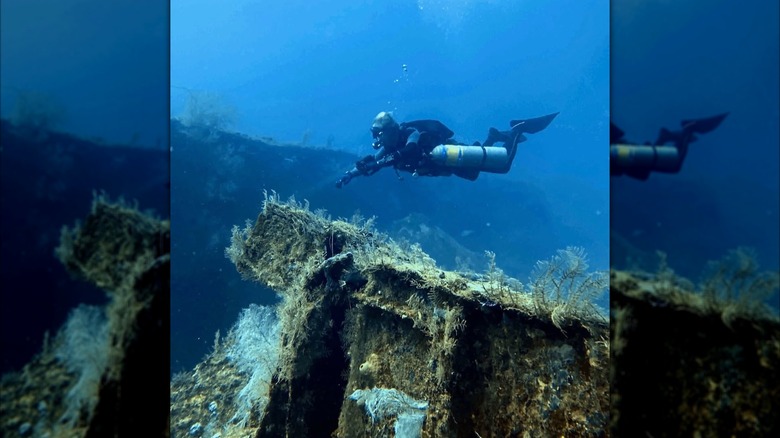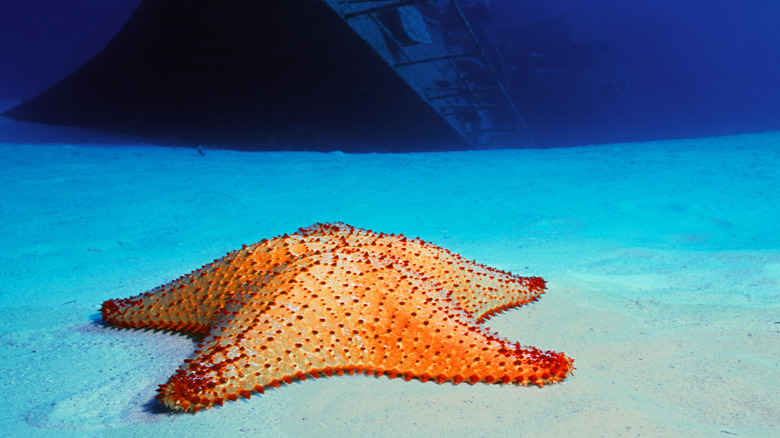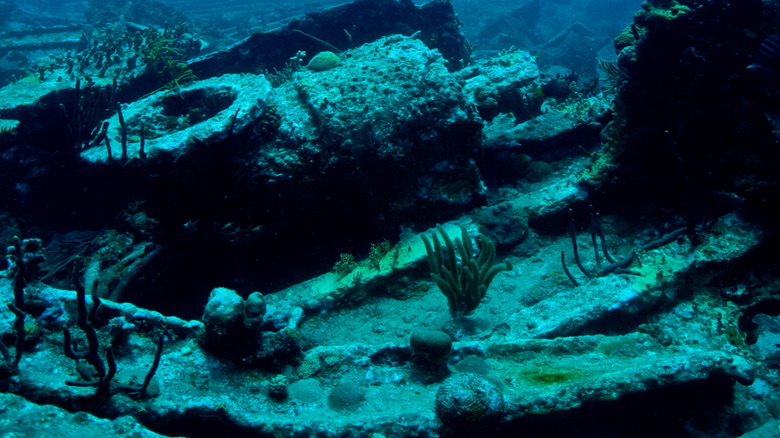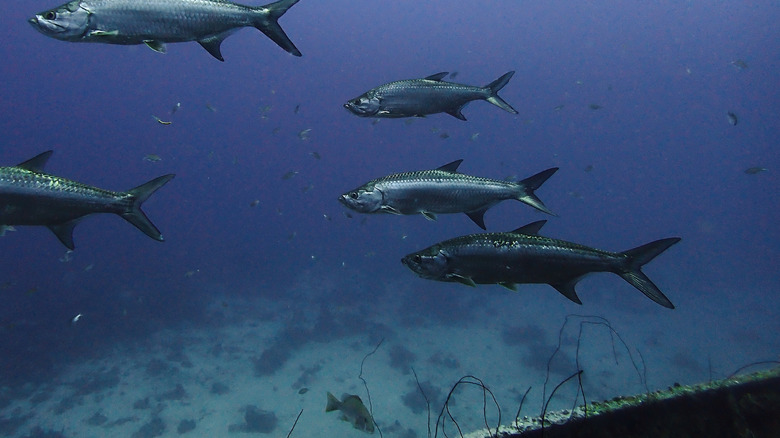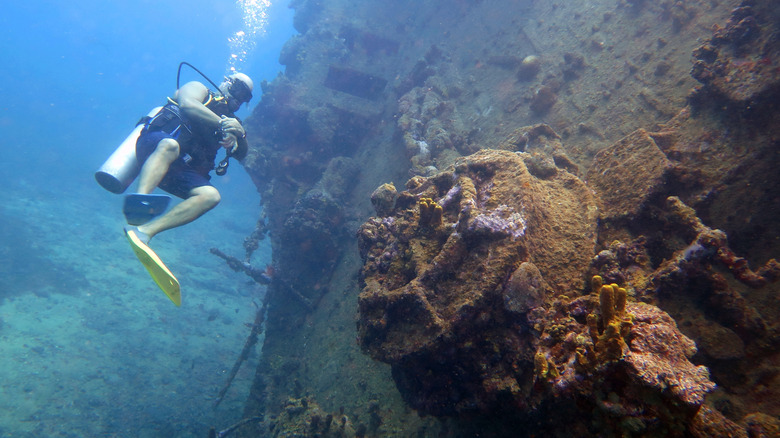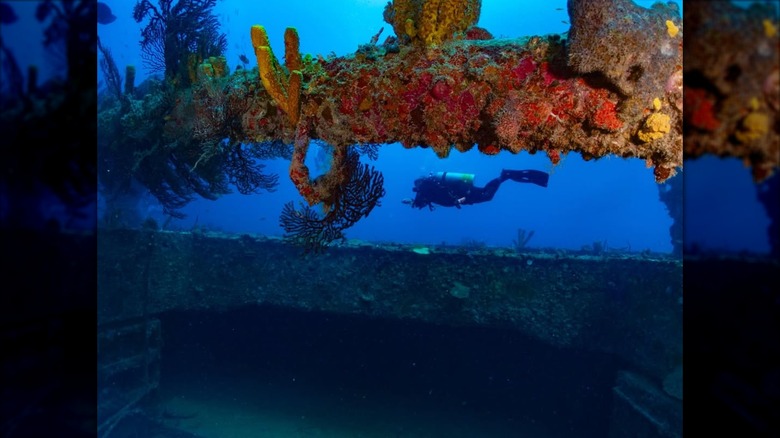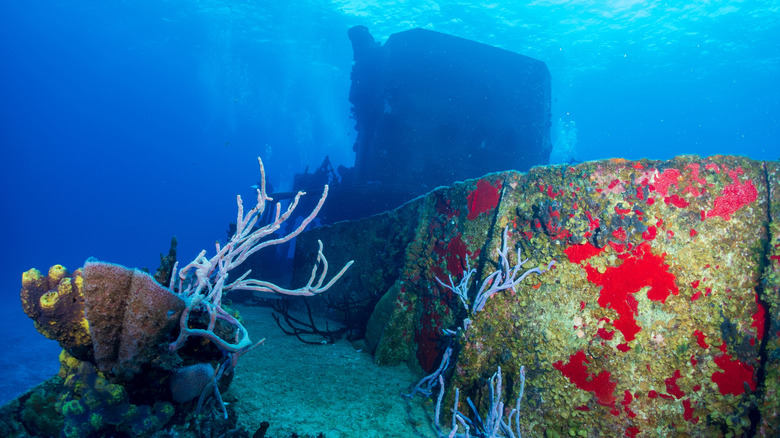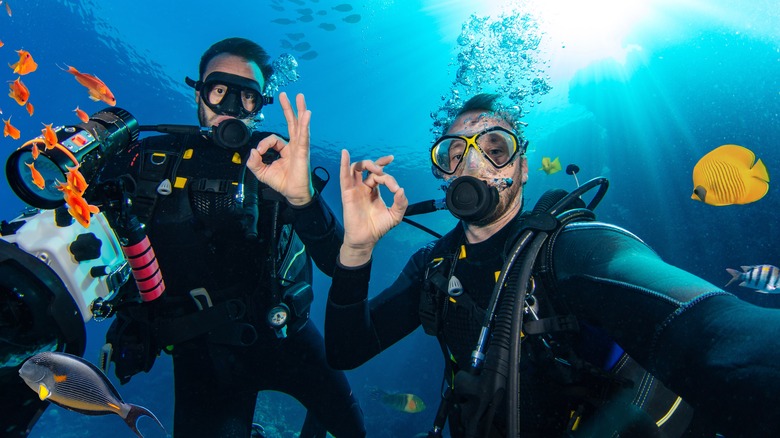10 Must-Dive Shipwrecks In The Caribbean, According To Divers
We may receive a commission on purchases made from links.
When you think of the Caribbean, you might imagine sunset-inspired cocktails, golden sand beaches, and bluer-than-blue skies. But there's another color-drenched world lurking just offshore beneath those turquoise waters. In fact, there's a whole sea of world-class diving with an abundance of marine life and reefs to keep even the most seasoned divemaster happy for years. However, if colorful sea fans, sponges, and coral aren't quite enough for you, the Caribbean also has some superb wreck diving.
The region is home to a variety of shipwrecks, from purpose-sunk boats to those lost to war, fire, storms, and even spectacular incompetence. And while some sit in waters shallow enough for snorkeling of all skill levels, others sit deep down in the murky depths in eerie silence. Some are broken apart by hurricanes; others are the victims of time. They offer up dark corridors and shadowy rooms to explore, while coral-covered machinery is waiting to be captured by underwater photographers.
This list rounds up some of the best wreck dives in the Caribbean, wrecks that are consistently talked about by divers in forums, magazines, and travel sites. You'll find Cold War frigates split in two, cruise liners with endings sad enough to be a movie plotline, and drug-smuggling freighters that could well be the subject of the next big Netflix documentary. Each one has a unique backstory, and they all serve up a variety of marine life as an added bonus. So, if it's more than just pretty reefs you want from your next dive, grab your torch and TG-7 and get down to those depths to explore the best wrecks the Caribbean has to offer.
The USS Kittiwake, Grand Cayman
The Cayman Islands has some of the best beaches in the Caribbean, but Grand Cayman also happens to be one of the best for snorkeling and diving. One of the top attractions is a purpose-sunk wreck situated just off the shore of the island's longest and most popular stretch of sand, the world-famous Seven Mile Beach. Before becoming a diver's domain, the USS Kittiwake was a U.S. Navy submarine rescue ship, and it has a history as colorful as the fish that have now made it their home.
Launched in 1945, it spent nearly five decades shadowing submarines, retrieving torpedoes, and aiding stranded refugees. It even played a major role in retrieving the black box of the Challenger space shuttle back in 1986. After being decommissioned in '94, it was donated to the Cayman Islands, where it was stripped clean and kitted out with dive-friendly access points. In 2011, it was purposefully sunk, and divers now flock to this 250-foot-long, five-deck-high behemoth for world-class wreck diving.
You'll find everything from propellers and winches to recompression chambers and the mess hall where the sailors all ate together. It's swarming with marine life, too, including turtles, barracuda, horse-eye jacks, shrimp, angelfish, and moody-looking groupers. If you set off early enough, you'll be one of the few on the deck at dawn. If not, expect to share it with a flood of GoPro-wielding divers and the inevitable influencers posing at the captain's wheel. Experienced traveler and master scuba diver Nathalie wrote positively about the USS Kittiwake wreck dive when she said on her Freedom Tour Travel blog, "By far the best wreck dive we have done. Visibility was amazingly clear, and the shipwreck is so well opened up that penetration even for novice wreck divers is easy."
The Hilma Hooker, Bonaire
As we pointed out way back in 2010, the stunning island of Bonaire has long been known as the shore-diving capital of the world. With 54 sites easily accessible from the sand, it's basically a shore-diving dreamland, and no site attracts more than the Hilma Hooker. This 236-foot freighter sits in 100 feet of crystal-clear water with perfect visibility and is within easy swimming distance from Pink Beach.
The ship is another with a colorful backstory, given that when it washed up in Bonaire's waters, it was carrying an illegal cargo of 25,000 pounds of marijuana tucked neatly behind a false bulkhead. The crew was arrested and the ship abandoned, but as it was evidence in a criminal court case, it could not be sold, salvaged, or sunk. Unsurprisingly, nobody ever came forth to claim the vessel, and the ship's condition gradually worsened. It required constant pumping just to stay afloat, and with the threat of sinking always on the cards, it eventually became a danger to other vessels. Local dive operators then lobbied the Bonaire government to move the ship away from the busy port area. The authorities agreed and conveniently placed it between two thriving coral reefs. The pumps soon failed (also considered another coincidental convenience by some), and the Hilma Hooker rolled over onto her starboard side and sank.
Today, it lies intact on its side and is swarmed by marine life. Bright sponges cling to the hull while garden eels poke up from the sand and hulking tarpon cruise the shadowy edges. And while it is a renowned site for diving, actually entering the wreck is best left to those with more advanced certification due to heavy doors, tangled debris, and poor visibility in some dark areas.
The Bianca C, Grenada
As we have discovered so far, a good wreck usually comes with a good backstory, and the Bianca C is often referred to as the "Titanic of the Caribbean." Back in 1961, this 600-foot Italian cruise liner sank just off Pink Gin Beach when an explosion in its boiler room triggered a fire. All 362 passengers were evacuated while British naval forces tried to tow the burning ship out of the harbor. However, the towline snapped, the rudders jammed, and the Bianca C went down in a blaze of glory. It now rests in 165 feet of water, enthralling wreck divers from all over the world.
However, it's no lazy float-through. Due to strong currents and the ship's enormity, most divers only manage to see part of it in a single dive. Back in the day, it was possible to freely swim inside and explore the cabins and ballroom. But nowadays, with decades of saltwater having taken its toll, sections of this hulking relic have collapsed, and you now enter at your own risk. That said, the sight of the ship's massive bow disappearing into the blue is still one of the Caribbean's great wreck-diving moments.
However, according to divers on ScubaBoard, a dedicated scuba diving forum, this one is for wreck rats only. A small group of divers there generally claims the site is not really worth exploring if you're looking for an abundance of marine life. While sponges and corals have rooted themselves across the twisted hull, and there are sightings of barracuda and eagle rays cruising by, it's the sheer scale and haunting atmosphere of the ship that leaves the bigger impression.
The MV Captain Keith Tibbetts, Cayman Brac
Wreck-diving is one of the best things to do in the Cayman Islands. The MV Captain Keith Tibbets is unique in that it is the only Soviet warship accessible to recreational divers in the Western Hemisphere. It was built in 1984 for the Cuban navy and had the ominous name of Destroyer #356. In 1996, the Cayman Islands government purchased the 330-foot Koni-class frigate with the purpose of sinking it off Cayman Brac, creating an artificial reef to attract wreck divers. After it went down, it was renamed in honor of local politician and scuba diver Captain Keith Tibbets, who was instrumental in promoting tourism on the island.
It now sits proudly in 80 feet of perfect waters, albeit in two distinct pieces after a hurricane split it in half in 2004, and offers visibility of up to 100 feet on a good day. The bow section still sits upright and shows off its Cold War hardware, while the stern is a broken mess of steel and coral growth. There are turret guns covered in tube sponges, giant sheets of twisted metal, and long corridors of marine life, including barracuda, snappers, and armies of reef fish that have made the wreck their own.
For anyone who likes their wrecks big, battered, and with a side dish of Cold War history, the Tibbetts wreck dive is well worth doing. One diver on TripAdvisor summed the experience up by saying, "Very cool wreck dive. Not too deep. No current, at least not the day we dived. The dive boat mooring line connects to the wreck, so it's virtually impossible to get lost. Only one real entry point due to hurricane damage. The guns make for very nice photos."
The RMS Rhone, British Virgin Islands
The RMS Rhone was a 310-foot Royal Mail Steamer built in 1865. Thanks to its iron hull and massive steam engine, the ship was thought to be unsinkable. However, after a hurricane hit the British Virgin Islands in 1867, it broke in two after smashing against Black Rock Point, claiming 123 lives. It lies in two sections between 20 and 80 feet of Caribbean waters on the seabed and has become one of the area's most iconic wreck dives.
The bow section remains relatively intact, while the stern is scattered across the reef. Open sections of the hull give divers channels to weave through and peer at giant wrenches and tools left behind in the cargo hold more than a century and a half ago. You can also swim straight through the ship's once-imposing drive shaft tunnel while marveling at the abundant marine life on display.
Turtles, barracuda, eels, and schools of grunts have long since moved in, while you can also see moody groupers, rays, and octopuses lurking and gliding among the colorful coral and sponges. The dive is very popular with TripAdvisor reviewers, with one commenting, "Your head is on a swivel the entire dive as you see countless amazing fish and a well-preserved wreck from the 1860s." It's all very impressive. So much so that it also boasts 'movie location' on its C.V., having been the center of the plot line in 1977's "The Deep," starring Jacqueline Bisset and Nick Nolte.
The Superior Producer, Curaçao
The sinking of the Superior Producer isn't quite as storied as other shipwrecks on this list. Rather than going down in a storm or naval skirmish, it sank because it was overloaded with cargo that wasn't properly secured. It also didn't help that the crew had left portholes open. This event took place on September 30, 1977, after the 165-foot freighter entered Curaçao's harbor to load Christmas cargo — including whiskey, perfume, and clothing — bound for Venezuela. As it left Willemstad Harbor, the ship started to take in water. The crew immediately jumped overboard, and the freighter began rolling within minutes and went down a few hours later, taking all the Christmas goodies with it. However, this prompted a massive looting spree, and all the cargo was salvaged and dispersed throughout the island within days.
The wreck rests in about 100 feet of water, not far from the Megapier cruise dock. Due to port security rules, diving the wreck was off-limits for years. However, recent changes have seen a limited number of dives take place when no cruise ships are moored. The ship is thankfully still largely intact, with the bridge, cargo holds, and mast all visible and smothered in orange cup coral and other invertebrates. Additionally, you'll see tarpon hovering in the shadows, while lionfish and moray eels lurk in the nooks and crannies along the rails. Schools of colorful reef fish pulse through the upper deck, and with light currents, easy shore entry, and excellent visibility, it has become one of Curaçao's most popular dive sites and one of the best wreck dives in the entire Caribbean.
The Antilla, Aruba
The Antilla was built in Germany in 1938 and posed in neutral Dutch waters as a harmless cargo ship. However, it was actually stocking up Nazi U-boats in the area with everything they needed, including munitions. Once Germany invaded the Netherlands, the Dutch navy made its move, quietly boarded the freighter under the cover of night, and demanded that the crew surrender. However, the German captain of the ship asked for a few minutes' grace period to collect personal items, and the Dutch courteously agreed. Yet, the German captain was shrewd and used the minutes he had been given to sabotage the ship. Within no time, the Antilla was sinking in shallow waters just off the northern coast of Aruba.
Today, this 400-foot freighter sits in 60 feet of water near Malmok Beach and is one of the biggest wrecks you can dive in the Caribbean. Much of the hull remains intact and visible from the surface, making it not only a staple for scuba divers but also an excellent site for snorkelers. Many visit every day, and despite the traffic, the wreck retains a sense of scale and atmosphere. Divers can explore the cargo holds, corridors, and decks that are now blanketed in coral and crawling with marine life of all sorts. You can also see synchronizing silversides and hovering barracuda while tropical fish move through open spaces.
It's an underwater photographer's paradise with the ship's striking silhouettes and fractured sunlight dramatically piercing through portholes, while small marine life is tucked into crevices, offering macro photographers ample opportunities. Underwater artists Dominique Serafini and Cathy Salisbury summed the wreck up on their Dreamwrecks website, saying, "It's an absolute pleasure to the eye and to the camera lens."
The SS Stavronikita, Barbados
Barbados may be home to some of the world's best beaches, but it also has a spectacular wreck dive in the SS Stavronikita, a Greek freighter whose demise came about in 1976. A fire broke out while it was anchored off the west coast of Barbados, and the ship was left beyond repair. It was soon abandoned and left in legal limbo for months until the Barbadian government stepped in and bought the 365-foot behemoth with the intent of deliberately sinking it and creating an artificial reef. It was dropped just offshore, where it landed in 130 feet of water perfectly upright.
Coral, sea fans, and sponges now cover most of this superstructure, while hawksbill turtles, the occasional barracuda, colorful schools of creole wrasses, porcupinefish, and moray eels patrol the open areas and hideouts. However, novice divers, take note: This is no casual swim. The depth, currents, and narrow access points make this one for experienced divers only. In fact, advanced certification is a requirement to take this dive.
Those qualified get to enjoy one of the most structurally intact wrecks in the whole of the Caribbean, with the hull in solid condition and the towering masts rising to within 20 feet of the surface. Visibility is usually excellent, and divers can drop straight down onto the ship's bow to capture wide shots of its sheer scale or glide through dim cargo holds to experience something a bit moodier. So, for those qualified and curious, the Stavronikita rewards your efforts.
The C-53 Felipe Xicotencatl, Cozumel
Cozumel is a diver's paradise with an abundance of marine life, world-renowned reefs, crystal-clear visibility, and, of course, some notable wreck dives. The Felipe Xicoténcatl, AKA the C-53, is the primary reason for wreck divers to suit up. It was originally commissioned as a U.S. Navy minesweeper during World War II but was later transferred to the Mexican Navy in 1962 to serve as a rescue and patrol vessel. It performed its duties there for almost four decades before retiring and being intentionally sunk, allowing it to spend its days as an artificial reef just off Chankanaab Park.
Today, the 184-foot-long ship resides in just over 80 feet of water, with the top structure rising to around 60 feet. Advanced open-water certificate holders can explore deeper depths, but the site is accessible to confident divers of all abilities. Entering the wreck is permitted, and wide openings into the bridge, engine room, and lower compartments have all been modified for safe diving. The current is mild to none, and visibility is excellent. You'll be able to spot grunts, angelfish, groupers, barracuda, and schooling jacks moving in synchronized spirals, while technicolor coral and sponges have started to creep along this wreck's hull and deck.
One scuba-diving Redditor said on the platform, "I did this a few years ago; it's a fun wreck for a purpose-sunk wreck. Lots of stuff still inside, namely the engines." Another inquired, "Did you get to sit on the toilet seat?" to illustrate just one of the memorable things you can do on this fun wreck dive.
Methodology
We scoured some of the top scuba diving websites, including Zublu Diving, Divernet, and Scuba Diver Life, to get their specific recommendations for Caribbean wreck dives. We only included wrecks that were consistently mentioned in a positive fashion by these diving experts. We also consulted cruise and travel publications like Fodor's and Travel Age West to get their views, while we also got the views of divers from dedicated scuba forums like Scubaboard and those on Reddit, TripAdvisor, and Quora. Additionally, we looked for Caribbean wreck dives that were considered to be among the best in the entire world. We considered the views of publications like National Geographic, PADI, Scuba Diving Magazine, and DIVE Magazine and made sure their thoughts on world-class wreck dives were included in our list.
